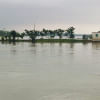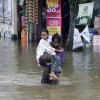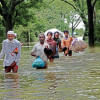Floods in Sylhet: Thousands in dire need of relief

With the waters receding in some areas, the flood situation in the Sylhet region started showing signs of improvement yesterday. However, due to an insufficient supply of relief items, thousands of people who are stranded in remote areas continue to suffer and are in desperate need of assistance.
According to official data, some 2,603 tonnes of rice along with around Tk 75 lakh cash assistance and 12,493 sacks of dry food have been allotted for the flood-affected people in the region.
While the government officials concerned said that enough relief supplies had been allocated and more aid was on its way, flood victims and members of civil society argued that the allocation was insufficient given the number of people affected by the flood and should be increased.
According to official data, the flash floods have marooned some 22.46 lakh people in the division's three worst-affected districts: Sylhet, Sunamganj, and Moulvibazar. Of them, 57,889 people were still at the shelters till yesterday.
While supplies for relief were given to those staying at the shelter centres, people living outside the shelters told this newspaper that as of yesterday, they had not received any supplies.
Md Abdullah and Shelly Begum of Sunamganj's Chhatak Monhanpur village, who lost their home in the flood, said they were struggling to manage food as no government relief reached them.
"We are somehow surviving on the food given to us by our neighbours in the area," said Abdullah.
The couple has now taken shelter at their neighbour's home, which was flooded as well but not as badly as other houses.
They also said they lost all their rice stored at the house when it got flooded.
Sufi Alam Sohel, chairman of the Islampur union in Chhatak upazila, said the flash floods severely damaged at least 800 houses while thousands of families lost their stored paddy as they live at the foothills of India's Meghalaya state.
"As an emergency response, I was allotted only 10 maunds of rice and three sacks of dry food, which was barely enough to feed the people at the shelters, let alone all the affected people in the union," he told this newspaper.
Another 17 tonnes of rice have been allotted for the union, but that has yet to arrive. "But that too will be inadequate," he added.
Kanon Alam, an advocate of the Supreme Court, said he was at his home in Azampur village of Sunamganj's Dowarabazar upazila when the flash floods first hit.
"In the last couple of days, I have closely observed the struggle of the affected people. The government allotment is so small that many people would have been starved if the solvent locals did not lend their support," he said.
Faruque Mahmud Chowdhury, president of the Sylhet divisional unit of Sushashoner Jonno Nagorik (Shujan), said that on the one hand, the amount of relief provided is insufficient, and the distribution is also questionable.
"The process of distributing relief provides an opportunity for local representatives to commit irregularities," he said, calling for adequate supply and transparency in distribution.
Abdul Karim Kim, coordinator of Songkhubdho Nagorik Andolon Sylhet, said the Sylhet region gets affected by floods every year, yet the government fails to allot adequate relief.
"The government ought to provide relief assistance to the people in proportion to their needs."
Speaking on the matter, Debojit Singha, additional divisional commissioner (general) of Sylhet, said, "As general relief, we have received enough cash, rice, baby food, and animal feed. Additionally, 26,000 relief packs with 14 essential items have been provided by the Prime Minister's special relief fund.
"Reaching those residing in shelter centers was our top priority because they are the most severely affected and they have received relief multiple times. We are aiming to extend relief efforts to the people left in the villages and remote areas now that we have received a new allocation."
According to the Water Development Board (WDB), as of 9:00am yesterday, the water level of the Surma River was flowing 16cm above the danger mark at Sylhet point and 65cm above the danger mark at Kanaighat point.
On the other hand, the Kushiyara River was flowing 61cm above the danger mark at Amalsid point, 13cm above the danger mark at Sheola point, 1.2cm above the danger mark at Fenchuganj point, and 24cm above the danger mark at Sherpur point.
Shah Mohammad Sajib Hossain, Assistant Meteorologist at Sylhet Weather Office, told UNB that there was no rainfall from Thursday noon till Friday morning.
Meanwhile, the local meteorological department has predicted moderate to heavy rains in some parts of Sylhet for the next few days due to active monsoon conditions.
In the past three weeks, Sylhet city has been inundated five times due to heavy rains, affecting hundreds of areas and causing untold suffering to the dwellers.
Earlier, on May 29, heavy rains and hill torrents from upstream caused flooding in Sylhet. The flood situation began to normalise on June 8.
However, continuous rains starting in the early hours of June 17 led to another flood in the district.
Prior to this, in May, floods were caused by hill torrents and rains from upstream in India.
CORRECTION
The Sylhet floods story in Friday's newspaper mentioned that 103,776 people were at shelters when, in reality, over 51,000 people moved to shelters. We apologise for the inadvertent mistake.


 For all latest news, follow The Daily Star's Google News channel.
For all latest news, follow The Daily Star's Google News channel. 











Comments